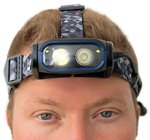Head Torches
A head torch sometimes referred to as a headlamp or headlight is a light source that is strapped to a person’s head or helmet to provide illumination during the night or in places of dark conditions, providing hands-free, portable lighting.
This form of lighting was invented in 1898 by British inventor David Misell. Misell combined existing technology of batteries created in 1866 and the incandescent light bulb invented in 1879, patenting his invention in 1898. Due to this, his invention was recognised as the world’s first mass-produced head torch, quickly becoming popular among cyclists and later a practical choice for lighting for mine workers.
What are head torches used for?
Head torches are used for a multitude of purposes, from commercial to leisure applications. Ultimately, they are used to provide hands free illumination in a dark area or to a particular subject. Common commercial applications you’ll see head torches used are underground mining, search and rescue operations, surgery and electrical/mechanical labour. On the other hand you will also find head torches used for leisure applications including camping, spelunking, hiking, bicycle riding and skiing.
How many lumens should a head torch be?
How many lumens a head torch should be is entirely dependent on your personal needs, as many head torches provide widely different levels of brightness from as little as 15 lumens to as high as 1100 lumens. Another factor to consider is the beam distance, as some head torches provide a greater illumination distance at the cost of brightness and vice versa. Regardless, 100-450 lumens is where you will generally find most head torches that are used for leisure outdoor activities, with commercial head torches often having 500+ lumens to ensure quality light output for attention to highlight detail.
Are head torches safe?
Head torches are created with safety at the forefront of its design. Designed to wrap tightly around your head to avoid accidentally hooking on a passing branch or sliding down your face and impeding your vision, head torches can be wrapped around helmets to not compromise safety in order to create illumination. Furthermore, many head torches have IK and IP Ratings, this allows them to be protected against impacts and water damage, preventing any damage that comes as a result of a broken bulb or circuitry. This is especially critical in working environments such as underground mines or caves.
What is a COB head torch?
A COB head torch is a type of head torch that utilises Chip on Board (COB) technology during its creation, this differs from the more commonly used technology called Surface Mounted Diode (SMD). These names refer to how the chips (LED diodes in this case) and integrated circuits are attached directly to a printed circuit board. As opposed to this, SMD (Surface Mounted Devices) refers to how the LED chips are mounted directly on one side of the printed circuit board using surface mount technology, as opposed to being on board when created.
This also results in a visual difference between COB and SMD as COB results in a smooth or spotless output as opposed to SMD which can result in a seemingly dotted finish.
How long do you need to charge a head torch for?
How long a head torch takes to charge depends upon the head torch itself, generally it can take between 2-4 hours to fully charge a head torch’s batteries, however we recommend viewing the product’s data sheet or technical specifications to be certain how long your head torch will take to fully charge. As well as this, you can actively extend the battery life of head torches by reducing the brightness output of the light, allowing them to go from lasting 4 hours from continuous use up to a staggering 60 hours of continuous use with many head torches able to last even longer.


















